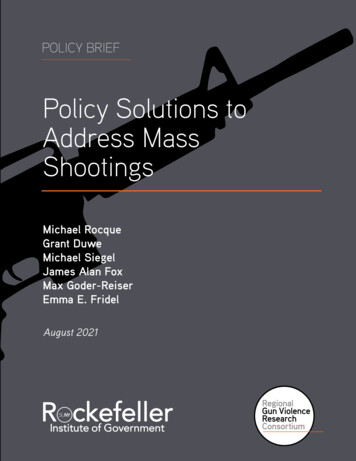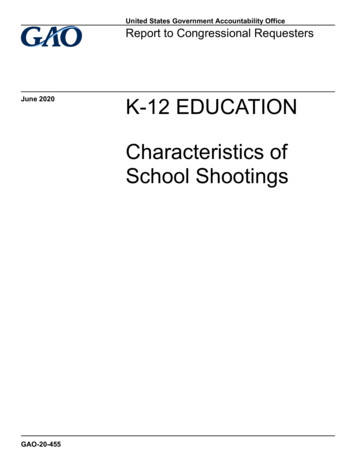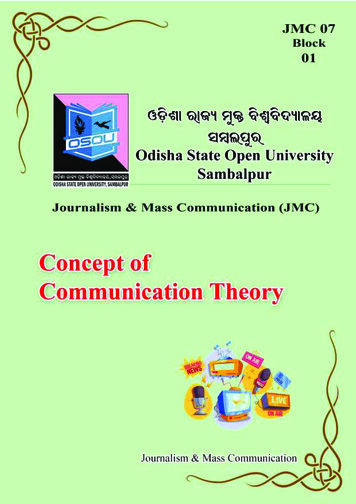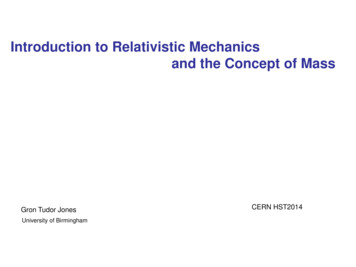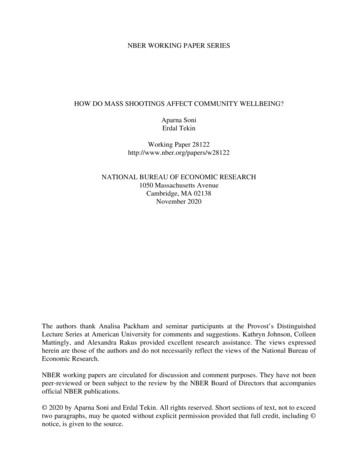
Transcription
NBER WORKING PAPER SERIESHOW DO MASS SHOOTINGS AFFECT COMMUNITY WELLBEING?Aparna SoniErdal TekinWorking Paper 28122http://www.nber.org/papers/w28122NATIONAL BUREAU OF ECONOMIC RESEARCH1050 Massachusetts AvenueCambridge, MA 02138November 2020The authors thank Analisa Packham and seminar participants at the Provost’s DistinguishedLecture Series at American University for comments and suggestions. Kathryn Johnson, ColleenMattingly, and Alexandra Rakus provided excellent research assistance. The views expressedherein are those of the authors and do not necessarily reflect the views of the National Bureau ofEconomic Research.NBER working papers are circulated for discussion and comment purposes. They have not beenpeer-reviewed or been subject to the review by the NBER Board of Directors that accompaniesofficial NBER publications. 2020 by Aparna Soni and Erdal Tekin. All rights reserved. Short sections of text, not to exceedtwo paragraphs, may be quoted without explicit permission provided that full credit, including notice, is given to the source.
How Do Mass Shootings Affect Community Wellbeing?Aparna Soni and Erdal TekinNBER Working Paper No. 28122November 2020JEL No. I1,I12,I18,I31,K4ABSTRACTOver the past four decades, more than 2,300 people have been the victims of mass shootingsinvolving a firearm in the United States. Research shows that mass shootings have significantdetrimental effects on the direct victims and their families. However, relatively little is knownabout the extent to which the impacts of these tragedies are transmitted into communities wherethey occur, and how they influence people beyond those directly affected. This study usesnationally representative data from the Gallup-Healthways survey to assess the spillover effectsof mass shootings on community wellbeing and emotional health outcomes that capturecommunity satisfaction, sense of safety, and levels of stress and worry. We leverage differencesin the timing of mass shooting events across counties between 2008 and 2017. We find that massshootings reduce both community wellbeing and emotional health. According to our results, amass shooting is associated with a 27 percentage point decline in the likelihood of havingexcellent community wellbeing and a 13 percentage point decline in the likelihood of havingexcellent emotional health four weeks following the incident. The effects are stronger and longerlasting among individuals exposed to deadlier mass shootings. Furthermore, the reductions inwellbeing are greater for parents with children below age 18. Our findings suggest that massshootings have significant societal costs and create negative spillover effects that extend beyondthose immediately exposed.Aparna SoniSchool of Public AffairsAmerican University4400 Massachusetts Ave NWWashington, DC 20016asoni@american.eduErdal TekinSchool of Public AffairsAmerican University4400 Massachusetts Avenue NWWashington, DC 20016-8070and IZAand also NBERtekin@american.edu
1. IntroductionThe United States is experiencing a gun violence epidemic. A particularly tragic aspect ofthis epidemic is the incidents of mass shootings occurring in communities throughout thecountry. Although there is no universally accepted or official definition of mass shooting, thegeneral criteria used to categorize an event as a mass shooting incident is the murder of four ormore people (not including the shooter) with a firearm in a single incident that is not related tomore conventionally motivated crimes such as armed robbery, gang shootings, or drug violence. 1Despite the lack of an official definition, the general perception is that the frequency of highfatality indiscriminate killings in public has risen significantly in recent years (Agnich, 2014;Lowe & Galea, 2015, 2017; Webster, 2017; Lin et al., 2018). 2 Moreover, the coverage of massshootings in the media has increased substantially over time, which has then led to a greaterpublic awareness of these tragic events (Roeder, 2016; Jetter & Walker, 2018).3 Recent evidenceshows that mass shootings also evoke high policy interest, despite the fact that they account forless than one percent of firearm deaths annually in the United States (Luca et al., 2020). 41This definition is consistent with those in two recent reports produced by the Congressional Research Services(Bagalman et al., 2013; Krouse & Richardson, 2015) and a classification report commissioned by the FederalBureau of Investigation (Morton & Hilts, 2008).2Given the differing opinions on what constitutes a mass shooting and the period over which to observe trends,there is a disagreement about whether the frequency of mass shootings has risen or remained steady. For example,focusing on a period between 2006 and 2019 and relying a database compiled by USA Today, Ferguson (2019)argues that the frequency of mass shooting incidents has not increased. Similarly, Fox & DeLateur (2014) conduct avisual inspection of the mass murders between 1976 and 2011 compiled from the FBI’s Supplementary HomicideReporting (SHR) and conclude that the number remained stable over that period. However, it is important to notethat both these studies rely on a more comprehensive definition of mass shooting that does not distinguish betweenpublic and non-public venues and includes mass shootings related to gang activity, domestic violence, and drugdeals. Some argue that mass shootings that stem from domestic violence, gang activity, organized crime, or drugdeals are contextually distinct from indiscriminate killings in public venues, and therefore should be classifiedseparately (e.g., Duwe et al., 2002; Gius, 2015). More restrictive definitions (e.g., Mother Jones) that focus onhigher-profile events motivated by mass murder in public venues point to a clear upward trend in recent years.3According to LexisNexis, the number of news stories mentioning “mass murder” has increased from a little over1,000 to almost 38,000 annually between 2010 and 2019.4Luca et al. (2020) show that a single mass shooting leads to a 15 percent increase in the number of firearm billsintroduced within a state in the year after a mass shooting. Furthermore, the political party controlling the statelegislature appears to matter. Republican-controlled legislatures pass significantly more laws loosening gun3
Despite the attention that mass shootings galvanize in the public, the media, and amongpolicymakers, rigorous investigations of their health effects on survivors and their communitieshave been limited. 5 There is particularly little research on whether mass shootings have animpact on the mental health of indirectly exposed individuals, such as those who are not directwitnesses, but live within the communities where these shootings occur. While the direct victimsand their families arguably suffer the most serious consequences of mass shootings, andaccordingly receive the most attention, the overall effects may be more pervasive and extend farbeyond those directly exposed, resulting in adverse consequences on community wellbeing.Given the enormous societal costs associated with poor mental and emotional health, it istherefore critical to understand the effects of mass shootings on emotional wellbeing ofpopulations in order to assess the overall welfare consequences. 6 Evidence that these incidentsindeed have negative spillovers that extend beyond those immediately exposed could influencethe costs and benefits of policies to prevent or reduce the harmful consequences of massshootings. Relatedly, asking which groups of populations would suffer the worst repercussionsin terms of community and emotional wellbeing could have important implications for theoptimal targeting of public resources following incidents of mass shootings.In this paper, we examine the effects of mass shootings on the community and emotionalwellbeing of American adults, using data from the restricted-access Gallup-Healthways surveyrestrictions, while Democrat-controlled legislature do the opposite, but the effect for Democrat-controlledlegislatures is insignificant.5The urgent need for additional research on the health effects of mass shootings has also been articulated in recentstudies across disciplines (e.g. Iancu et al., 2019; Rowhani-Rahbar, Bellenger, & Rivara, 2019; Travers, McDonagh,& Elkit, 2018).6Mental disorders top the list of the most costly health conditions by a substantial margin, with spending at 201 billion annually (Roehrig, 2016).4
between 2008 and 2017. To our knowledge, our analysis represents the first nationwideinvestigation of the impact of mass shootings on emotional health of people living incommunities where these tragedies occur. Our primary source of data on mass shootings isMother Jones, an investigative news organization that maintains an open-source databasedocumenting high-profile, indiscriminate rampages in public places resulting in four or morevictims killed by the attacker. 7We identify the causal effects of mass shootings by exploiting the county-specificvariation in exposure to such events over time using a difference-in-differences research design.Our identification strategy is based on the premise that, conditional on residing in a county thatexperiences a mass shooting, whether the incident of the shooting occurs during the weeksbefore or after an individual is interviewed by Gallup is as good as random. Specifically, wecompare the community and emotional wellbeing of individuals who are interviewed by Gallupright after a mass shooting with those who are interviewed right before in counties whereshootings occur relative to other counties. We control for month-by-year and county fixed effectsin all specifications, thereby separating out the impacts of the mass shootings from other existingtrends in wellbeing.Our paper contributes to a growing literature on the effects of mass shootings onindividual and community health. Two notable and recent examples are Rossin-Slater et al.(2019) and Dursun (2019) who study the impact of mass fatal shootings on health outcomes.Rossin-Slater et al. (2020) examine the impact of fatal school shootings on the mental health oflocal youth, as measured by the use of prescription antidepressants. They find that local exposure7The Mother Jones database excludes shootings stemming from more conventionally motivated crimes such asarmed robbery or gang violence.5
to school shootings increases youth antidepressant use by about 21 percent in the following twoyears. Dursun (2019) studies the impact of in utero exposure to mass shootings on infant healthand shows that women who experienced a mass shooting in their county during pregnancy aremore likely to have very low birthweight and very premature babies. These studies are relevantfor our analysis not only because they consider health impacts of mass gun violence, but alsobecause they use an identification strategy similar to ours.In addition to the economic studies mentioned above, there is a sizeable literature inepidemiology, psychiatry, and psychology that studies the mental health impacts of massshootings. Many studies in this literature suggest a negative association between exposure tomass shootings and psychological health, as measured by posttraumatic stress symptoms,depression, anxiety, fear, and decline in perceived safety. 8 However, these are typically casestudies that consider single events and suffer from several methodological limitations, such asreliance on small samples, lack of control groups or pre-shooting data, and challenges togeneralizability from decades-old single events. Selective response bias is another importantproblem in some of these studies, as individuals who come forward to share their feelings in theaftermath of shootings are unlikely to reflect the sentiments of the entire community.Our results provide consistent evidence that mass shootings have adverse effects on theemotional and community wellbeing of American adults. Specifically, we find that a massshooting reduces the probability of having excellent community wellbeing by 27 percentagepoints and the probability of having excellent emotional health by 13 percentage points four8For example, one widely cited study interviewed 135 survivors after a mass shooting and found that 20 percent ofthe men and 36 percent of the women met criteria for PTSD (North et al., 1994). However, this study suffers fromlimitations such as small sample size and the lack of a control group. See Shultz et al. (2014) and Lowe & Galea(2017) for reviews of this literature.6
weeks following the incident. Furthermore, the effects are stronger and longer lasting for thoseexposed to mass shootings with more victims (e.g. for those exposed to shootings with 10 ormore victims). Our results are robust to alternative definitions of mass shootings and are notdriven by any particular subset of shootings.The rest of this paper is laid out as follows. We discuss the data in Section 2 and describethe estimation strategy in Section 3. The results are presented in Section 4, and Section 5concludes the paper with a summary of the overall findings and a discussion of the implications.2. DataMass Shooting DataOur list of mass shooting events comes from Mother Jones, an investigative newsorganization that maintains an open-source database of mass shootings (Follman et al., 2020). 9According to the criteria used by Mother Jones, an incident is defined as a mass shooting if theperpetrator took the lives of at least four people, excluding himself or herself, the shootingoccurred using a firearm in a public place, and it was not related to gang activity, armed robbery,or domestic violence. 10 Based on these criteria, Mother Jones identified 47 mass shootings thathad occurred between 2008 and 2017, in which a total of 426 individuals were killed and 898individuals were wounded. 11 The Mother Jones’s definition is consistent with the FBI’sclassification of mass murder (Morton & Hilts, 2008) and two recent reports produced by the9Mother Jones (https://www.motherjones.com) provides news, commentary, and investigative reporting on topicsincluding politics, the environment, human rights, health, and culture and has a readership of more than 10 millionpeople each month.10Since January 2013, Mother Jones included mass shootings that took the lives of at least three people, excludingthe perpetrator. Four of the 47 mass shootings used in our analysis have only three victims, but our results do notchange when we restrict the list of shootings to those with at least four victims.11There are four counties that had multiple mass shootings over our study period between 2008 and 2017. Treatmentassignment for these counties was made based on the first shooting.7
Congressional Research Services (Bagalman et al., 2013; Krouse & Richardson, 2015). TheMother Jones database is commonly used by researchers studying questions related to massshootings (e.g., DiMaggio et al., 2019; Gius, 2015; Lin et al., 2018; Pappa et al., 2019; Porfiri etal., 2019; Wallace, 2015).Figure 1 illustrates the distribution of mass shootings across counties in the U.S. Asshown in the figure, mass shootings are fairly sporadically distributed, with 26 states having atleast one mass shooting between 2008 and 2017. Figure 2 shows the number of mass shootingsover time along with a list of states where the incidents occur in each year. It is clear from thefigure that the number of mass shootings has trended upward over time, increasing from threemass shootings in 2008 to eleven incidents in 2017. Furthermore, California has the highestnumber of mass shootings with nine incidents during the analysis period, followed by fourincidents in Washington, and three shootings each in Colorado, Florida, and Texas.It is important to note that there are databases compiled by other news and researchorganizations tracking mass shootings (e.g., USA Today, Gun Violence Archive, and StanfordUniversity’s Mass Shootings in America database). These databases have larger counts of massshooting as they are based on different criteria, such as inclusion of incidents with non-firearmweapons, victim counts including those either killed or wounded, shootings that occur in nonpublic venues, and inclusion of more conventionally motivated crimes. While these largerlistings are useful for investigating the broader problem of violence, we believe our definition ofrandom, nonsensical, and indiscriminate shootings captured by Mother Jones is best suited for8
the purposes of our study, since it is exactly these characteristics that we argue are the source ofcommunity-wide mental health repercussions. 12In sensitivity analyses, we estimate our models using the USA Today database. Ourresults are robust to using this alternative measure. We did not perform sensitivity analyses withthe Gun Violence Archive (GVA) and Stanford’s Mass Shootings in America (MSA) databasesbecause the data collection started in 2014 for GVA and in 2012 for the MSA database.Furthermore, GVA differs from other datasets in that gang- and drug-related incidents areincluded. The MSA database relies solely on online media sources to identify mass shootingevents, The records in the MSA span a time period that includes the transition from traditionalmedia to digital media in reporting, and therefore, the numbers of incidents per year partiallyreflect the collection methodology and not just changes in incident frequency. For example, themore than threefold rise in mass shooting incidents from 2014 to 2015 shown in the Stanforddata likely reflects increased online reporting and not necessarily a true increase in the frequencyof mass shootings (Smart, 2018).Data on Community and Emotional WellbeingThe data on community and emotional wellbeing come from the restricted-access GallupHealthways survey (Gallup hereafter). The daily poll covers all 50 states and Washington D.C.and surveys more than 500 American adults on their perceptions of their own physical andmental health (e.g. health conditions, self-assessed health, and experiences of stress, worry, andjoy), financial wellbeing, social relationships (e.g. having supportive relationships), and12Taking a conservative approach also ensures that, if anything, our results would be a lower bound of the trueeffect of mass shootings on community and emotional wellbeing.9
community wellbeing (e.g. liking where they live, feeling safe, and having pride in thecommunity). Gallup data have been used in past research to study the effects of public policieson social, mental, and physical wellbeing (e.g., Flavin, 2018; Sommers et al., 2015). 13Importantly for our analysis, the restricted-access micro data provide the exact date of theinterview and respondents’ county of residence, which allows us to identify respondents whowere exposed to a mass shooting in their community. The data also contain rich demographicinformation, including respondents’ age, sex, marital status, parental status, race/ethnicity, andeducational attainment. Gallup weights the data daily to mitigate potential selection andnonresponse bias. With the use of sampling weights, the data are nationally representative.We use the Gallup data to construct eight main outcome variables of interest – threemeasures of community wellbeing (community wellbeing index, an indicator for excellentcommunity wellbeing, and an indicator for poor community wellbeing), three measures ofemotional wellbeing (emotional wellbeing index, an indicator for excellent emotional health, andan indicator for poor emotional health), an indicator for overall excellent community andemotional wellbeing, and an indicator for overall poor community and emotional wellbeing.We identify four questions in the Gallup related to community wellbeing. Specifically,respondents are asked to report on a scale from 1 to 5 how strongly they agree with the followingstatements: 1) I am proud of my community or the area where I live; 2) I always feel safe andsecure; 3) The city or area where I live is a perfect place for me; and 4) I am satisfied with the13Although the data in Gallup are self-reported, studies have shown that self-reported measures of wellbeing arestrongly suggestive of actual wellbeing. For example, those who report higher levels of satisfaction are also morelikely to laugh, smile, and demonstrate other behavioral characteristics indicative of happiness (Watson & Clark,1991; Myers, 1993; Myers & Diener, 1995). Self-reported measures of wellbeing also correlate strongly withassessments from peers, friends, family, and professional clinicians (Myers & Diener, 1995).10
city or area where I live. 14 For each of these four questions, we create indicator variables equal to1 for those who responded “agree” (4 on the 1 to 5 scale) or “strongly agree” (5) and equal to 0for those who responded “neither agree nor disagree” (3), “disagree” (2), or “strongly disagree”(1). We then construct an index measure (“Community Wellbeing Index”) equal to the sum ofthe four indicator variables. For ease of interpretation, we standardize the index by subtractingthe mean and dividing by the standard deviation. A higher “Community Wellbeing Index” valuesuggests that the respondent has a greater level of community wellbeing. We also create anindicator of “Excellent Community Wellbeing,” which takes on the value of 1 if the respondentanswered “agree” or “strongly agree” to all four of the above statements relating to communitywellbeing, and 0 otherwise. Similarly, a measure of “Poor Community Wellbeing” isconstructed as binary indicator, which is equal to 1 if the respondent did not answer “agree” or“strongly agree” to any of the four statements, and 0 otherwise.To measure emotional wellbeing, we use a series of questions in which the respondentsare asked to report whether they experienced certain emotions yesterday: 1) Did you smile orlaugh a lot yesterday?; 2) Did you experience a lot of enjoyment yesterday?; 3) Did youexperience a lot of happiness yesterday?; 4) Did you experience a lot of worry yesterday?; 5) Didyou experience a lot of sadness yesterday?; 6) Did you experience a lot of stress yesterday? 15 Forthe first three questions, we create indicator variables equal to 1 if the respondent replied “Yes”to the question and equal to 0 if the respondent replied “No.” The next three questions inquireabout negative emotions, so we create indicator variables equal to 1 if the response was “No”and equal to 0 if the response was “Yes.” We then construct an index measure (“Emotional1415These variables are consistently available for the years 2014 through 2016.These variables are consistently available for the years 2008 through 2016.11
Wellbeing Index”) equal to the sum of the six indicator variables. We standardize the EmotionalWellbeing Index for ease of interpretation. A higher “Emotional Wellbeing Index” suggests thatthe respondent has a greater level of current emotional health. We also create a measure of“Excellent Emotional Health,” an indicator variable equal to 1 if all six of the above indicatorvariables equal 1, and a measure of “Poor Emotional Health,” an indicator variable equal to oneif three or more of the above indicator variables equal zero.Finally, we construct two measures of overall community and emotional wellbeing.“Excellent Community and Emotional Health” is a binary indicator that takes on the value of 1 ifboth the “Excellent Community Wellbeing” and “Excellent Emotional Health” variables areequal to 1, and 0 if either indicator is 0. Similarly, “Poor Community and Emotional Health” isan indicator that takes on the value of 1 if both the “Poor Community Wellbeing” and “PoorEmotional Health” variables are equal to one, and 0 otherwise.We control for a number of individual characteristics in our models, including age, sex,marital status, parental status, race/ethnicity, and educational attainment. Table 1 presentssummary statistics for these variables separately for the treatment and control groups. As shownin the table, there are no statistically significant differences between respondents interviewedwithin a period 28 days prior to and after a shooting. The only exception to this pattern is age,where those interviewed post-shooting are on average one year older (p 0.05) than thoseinterviewed pre-shooting. We control for all these demographic variables in our regressionmodels. In supplementary analysis, we examine whether the impact of exposure to a massshooting is affected by several observable characteristics of the individuals by estimating ourmodels separately by sex, parental status, race/ethnicity, and educational attainment. In Table 2,we present the non-regression adjusted means of each outcome separately for the pre-shooting12
and post-shooting periods; all but one of the differences are not statistically significant betweenthe treatment and the control groups.3. Estimation StrategyOur goal is to estimate the causal impact of mass shootings on the measures ofcommunity and emotional wellbeing among persons living in communities where these incidentsoccur. We restrict our Gallup sample to respondents who lived in a county that ever experienceda mass shooting and who were interviewed up to 28 days before or up to 28 days after theshooting. 16 We exclude those who were interviewed on the exact day of the shooting because wecannot identify whether the interview occurred prior to or after the shooting on that day.We use a difference-in-differences (DD) research design to compare measures ofcommunity and emotional wellbeing after mass shootings occurred for individuals living in thecounties where these tragedies occurred, relative to individuals living in counties where massshootings had not yet occurred. Formally, the DD research design can be specified as follows:𝑌𝑌𝑖𝑖𝑖𝑖𝑖𝑖 𝛽𝛽0 𝛽𝛽1 ���𝑖𝑖𝑖 𝑋𝑋𝑖𝑖𝑖𝑖𝑖𝑖 𝛽𝛽2 𝛿𝛿𝑐𝑐 𝜏𝜏𝑡𝑡 𝜀𝜀𝑖𝑖𝑖𝑖𝑖𝑖 ,(1)where 𝑌𝑌𝑖𝑖𝑖𝑖𝑖𝑖 is an outcome variable of interest for respondent i in county c at time t;PostShootingict is an indicator that is equal to 1 if the respondent was interviewed after theshooting in his/her county, and 0 otherwise; 𝑋𝑋𝑖𝑖𝑖𝑖𝑖𝑖 is a vector of demographic variables includingage, sex, marital status, parental status, race/ethnicity, and educational attainment. We also16This approach is similar to the one used by Dursun (2019), who studies the impact of intrauterine exposure tomass shootings on birth outcomes using monthly data at the county level.13
include a vector of county fixed effects, 𝛿𝛿𝑐𝑐 , to control for all time-invariant differences acrosscounties, and month-by-year fixed effects, 𝜏𝜏𝑡𝑡 , to account for common time trends. Furthermore,all regressions are weighted by sampling weights provided by Gallup, and the standard errors areclustered at the county level using the wild cluster bootstrap method. The parameter of interest inequation (1) is 𝛽𝛽1 , which captures the impact of the county-level exposure to a mass shooting onadults’ emotional and community wellbeing.The specification in equation (1) is restrictive in that it imposes the relationship betweena mass shooting and the outcomes of emotional and community wellbeing to be constant overtime. This may especially be unlikely in our context if, following incidents of mass shootings,people go through multiple phases of coping, during which they exhibit particular emotions,behaviors, and other reactions (Alexander & Klein, 2005; Freedy & Simpon, 2007; Goldmann &Galea, 2014). 17 Standard DD estimates may be biased if the treatment effect is not constant overtime (Goodman-Bacon, 2018). Therefore, we next specify a more flexible, non-parametricmodel, in which the ���𝑐 indicator is replaced with a vector of variables indicatingthe number of weeks after the shooting:𝑌𝑌𝑖𝑖𝑖𝑖𝑖𝑖 𝛼𝛼 4𝑗𝑗 1 𝜗𝜗𝑗𝑗 1(𝑊𝑊𝑊𝑊𝑊𝑊𝑊𝑊𝑊𝑊 𝐴𝐴𝐴𝐴𝐴𝐴𝐴𝐴𝐴𝐴 �𝑜𝑜𝑖𝑖𝑖𝑖𝑖𝑖 𝑗𝑗) 𝛾𝛾𝛾𝛾𝑖𝑖𝑖𝑖𝑖𝑖 𝛿𝛿𝑐𝑐 𝜏𝜏𝑡𝑡 𝜀𝜀𝑖𝑖𝑖𝑖𝑖𝑖 . (2)17A report by the Substance Abuse and Mental Health Services Administration (SAMSHA) characterizes thesestages of healing as an acute phase immediately after the event, an intermediate phase several days to weeksafterward, and the long-term phase. The acute phase is typically characterized by denial, shock, and disbelief. Theintermediate phase is manifested by fear, anger, anxiety, transient panic, retaliatory attacks, difficulty payingattention at work or school, depressed feelings, and disturbed sleep. Finally, the long-term phase is characterized bycoming to terms with realities with alternate periods of adjustment and relapse (SAMHSA, 2017). Most survivorsdevelop resilience or an ability to successfully adopt to stresses in the long-term phase (Goldmann & Galea, 2014;Haglund et al., 2007). Some individuals may even feel greater self-worth and sense of life purpose, expressingfeelings of gratitude for having survived the mass shooting (Novotney, 2018).14
In equation (2), 1(𝑊𝑊𝑊𝑊𝑊𝑊𝑊𝑊𝑊𝑊 𝐴𝐴𝐴𝐴𝐴𝐴𝐴𝐴𝐴𝐴 �𝑜𝑜𝑖𝑖𝑖𝑖𝑖𝑖 𝑗𝑗) is a binary variable taking on thevalue of 1 if the respondent was interviewed j weeks after a mass shooting where j [1,4]. The 𝜗𝜗𝑗𝑗terms capture the impact of the shooting on the outcome Y in week j, relative to the entire preshooting period. All other terms in Equation (2) are defined as in Equation (1). Equation (2)represents our preferred model.The reliability of estimates in the difference-in-differences design hinges upon theassumption that the outcome variables would have trended similarly across counties in theabsence of a mass shooting. To assess the validity of this parallel trends assumption, we performan event study analysis that enables us to trace out the differences in the outcomes of wellbeingin the weeks leading up to and following a mass shooting. The event study analysis isimplemented by estimating an augmented version of equation (2), which includes binaryindicators of exposure to a mass shooting both in the weeks prior to or followi
epidemiology, psychiatry, and psychology that studies the mental health impacts of mass shootings. Many studies in this literature suggest a negative association between exposure to mass shootings and psychological health, as measured by posttraumatic stress symptoms, depression, anxiety, fear, and decline in perceived safety.
